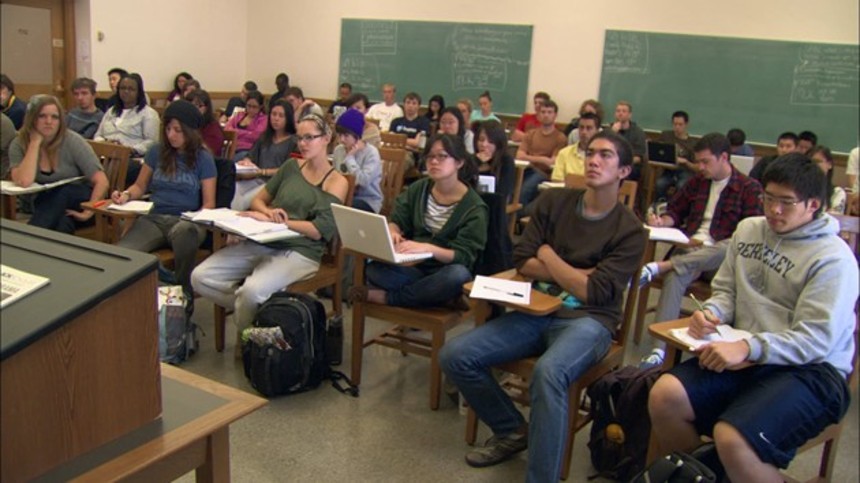New York Film Fest 2013 Review: AT BERKELEY, A Fascinating, Immersive Examination of the Famed Educational Institution

For 46 years now and counting, the 83-year old filmmaker Frederick Wiseman has carved out an endlessly fruitful niche within his chosen genre: the examination and function of various institutions. His methodology has remained unchanged since his first films in the 1960s as a practitioner of the cinema verité style of filmmaking: no voiceover, no interviews, no on-screen titles identifying speakers, no music cues. Wiseman gives us immersive, fly-on-the-wall experiences, letting editing and visual juxtapositions express the messages he seeks to convey about the places he chooses to film.
The great strengths, as well as certain weaknesses, of Wiseman's method are on full display in his latest, At Berkeley, a four-hour study of the famed of University of California campus, his 38th documentary and his 40th feature film overall. Culled from 250 hours of footage shot over 12 weeks in the fall of 2010, At Berkeley explores many different aspects of this sprawling environment, dropping in on classroom sessions, administrative meetings, various student activities to create a panoramic view that encompasses both the dramatic and mundane to afford us a fascinating view of this academic institution.
Wiseman happened to encounter Berkeley at a moment of economic crisis, as the school struggled to counteract the steadily decreasing amount of state support, while continuing to fulfill their mission of maintaining its status as a high-quality, affordable public school that continues to be accessible to as wide a swath of society as possible. The many board meetings we witness in the film, presided over by then-chancellor Robert Birgeneau, often discuss the strategies the administration considers as the best way to achieve these goals. These economic difficulties are the backdrop to many scenes of the film, from a young woman reduced to tears over the financial strain her attendance is putting on her family, to another young woman in a classroom discussion who sharply criticizes white middle-class students who seem to be only concerned about issues of economic struggles when it affects them directly.
However, despite these considerable challenges, life goes on as usual: students lounge on the grass and in the halls reading, female glee singers perform outdoors, football and hockey games happen, ROTC students do military training sessions, and school productions of Our Town and a satirical routine about Facebook are play out on stage. As usual in Wiseman films, even such seemingly mundane scenes as janitors sweeping the staircases, groundskeepers maintaining the manicured lawns, and construction on campus get thorough attention.
The most dramatic expression of Berkeley's financial crisis occurs in the film's final hour, on the day of a student protest over tuition hikes, culminating in some of the students occupying a library. This is the strongest and most dynamic section of the documentary, Wiseman's masterful cross-cutting illuminating both sides of the battle. The administration works out how to respond to the students' long, often diffuse and unfocused laundry list of demands and make contingency plans in case things get completely out of hand. Meanwhile, the students chant, give speeches, and debate amongst themselves during the library occupation. However, in a far cry from Berkeley's much more volatile history of student protest in the 60's, the situation is resolved without incident, the protestors clearing out at closing time, and business as usual is resumed. And all the students at the school are not exactly a united front on this issue: indifferent students lounge on the grass while protestors march past them, while others complain about the student action disrupting their studies.
While the extended length of At Berkeley impressively demonstrates Wiseman's commitment to giving the viewer a full sense of the texture of life at this institution, the structure of the piece, alternating between classroom, student life, and administration scenes, connected by wordless establishing shots, sometimes feels repetitive over the film's considerable length. Also, some scenes play a bit too long, reducing their effectiveness within the film's construction, as for example during an astronomy lecture so laden with academic jargon that it becomes almost comically incomprehensible.
However, in its best scenes and sequences, At Berkeley confirms Frederick Wiseman's status as one of our most vital filmmakers, illuminating the working structures and functions of institutions like no one else can, presenting a uniquely fascinating panorama of humanity.
At Berkeley screens in the New York Film Festival's main slate and is scheduled to open this November in New York at the IFC Center.
At Berkeley
Director(s)
- Frederick Wiseman

Do you feel this content is inappropriate or infringes upon your rights? Click here to report it, or see our DMCA policy.






